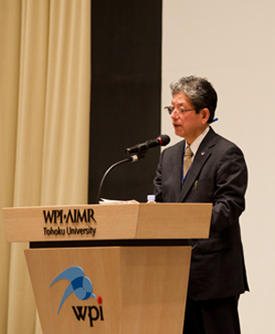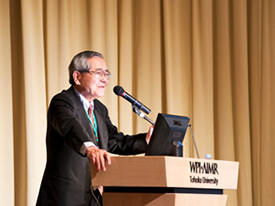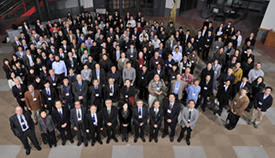

03/25/2013
Since its launch in 2007, the AIMR has built an enviable reputation for innovative fusion research in materials science, bringing together top international researchers in disciplines such as bulk metallic glasses, materials physics, soft materials and devices and systems. In 2012, a fifth research grouping — Mathematics Unit — was added, beginning a new chapter in the institute’s scientific development.
Held since 2008, the annual workshop — renamed as the AIMR International Symposium — provides a forum for AIMR researchers, including those based overseas, and other internationally renowned materials scientists to discuss the latest developments in the field. The sixth symposium was held at the Sendai International Center from 19–21 February 2013 under the banner theme of “Challenge for green materials innovation through the fusion of materials science and mathematics,” and drew more than 240 participants from 14 countries.

In contrast to previous years, the meeting attracted a significant number of attendees and four speakers from the field of mathematics, mirroring the recent focus on mathematics-driven materials science at the institute. AIMR director Motoko Kotani, herself a distinguished mathematician, welcomed the development but pointed out that it reflected a natural evolution of the profile of the center. “We included a session on mathematics and computational science and one mathematician in the opening session but that was all,” she said of the inaugural workshop. “[This year], as in previous years, we called for recommendations of speakers from our researchers, and chose the best from the list. I myself was surprised to find so many talks with mathematical hints in the symposium program. This shows our mathematics-driven materials idea has captured the imagination of our members.”
The decision to place mathematics-driven materials science at the heart of the AIMR’s research strategy was announced by Kotani at the 2012 workshop, and the initiative has gained form and momentum since then. “I explained our idea of math–materials science collaboration to accelerate interdisciplinary research at the conclusion of the workshop last year,” explained Kotani. “But at the time, although we were confident we made the right decision, our ideas for the collaboration were then still largely unformed. In the intervening period, through much discussion and consultation, we have established three target projects to give a concrete strategy to our idea, and worked intensively to pursue research in this direction for one year.” While acknowledging that it is still too early to claim that the AIMR’s mathematics–materials science collaborations have met the challenges of “green materials innovation,” Kotani remarked upon the encouraging initial results due to be presented at the 2013 symposium.
This year’s meeting was opened by Susumu Satomi, president of Tohoku University, who extended a formal welcome to the delegates and congratulated AIMR members on their development of world-class research programs. This achievement, and the research-first, practice-centered ethos of Tohoku University, has ensured that the AIMR continues to play a central role in the life of the university, he said. Further development of the institute would be strongly influenced by the success of the newly established, mathematics-driven materials science framework. Pledging the continued support of the university, the president also praised the international character of the AIMR and paid tribute to the role played by the institute’s 19 overseas partners, and 3 satellite institutions at the University of California, Santa Barbara in the US, the Chinese Academy of Sciences’ Institute of Chemistry and the University of Cambridge, UK.
Welcoming delegates to the symposium, Toshio Kuroki, program director of the World Premier International Research Center Initiative (WPI), which oversees the operation of the AIMR, reiterated the importance of mathematics-driven materials science research to the institute’s work. Introducing the mathematics–materials approach had given the AIMR a “new culture and paradigm shift,” in addition to a distinctive focus that complements the already high levels of research achievement established since its inception in 2007, Kuroki said.

In her symposium address, Kotani restated the institute’s goal to integrate materials science with physics, chemistry and engineering to create new materials that can contribute to society. Although a worthy and important aim, achieving this has not proved easy, Kotani noted. Working through the original AIMR launch plan had led to the realization that it was necessary to take greater account of the mathematical view of the field, she said. Further consideration had identified three target projects: Non-equilibrium Materials based on Mathematical Dynamical Systems, Topological Functional Materials, and Multi-scale Hierarchical Materials based on Discrete Geometrical Analysis, that now form the mainstay of research at the AIMR. Kotani also spoke of the importance of the AIMR as an incubator for international research talent and encouraged researchers from around the world to join the AIMR’s research programs.
Following the introductory addresses, the conference’s academic program began with a special opening lecture entitled “The Magical Power of Transition Metals: Past, Present and Future” by Ei-ichi Negishi from Purdue University in Indiana, US. Negishi, who shared the 2010 Nobel Prize in Chemistry for his work on transition metal-catalyzed cross-coupling reactions, gave a wide-ranging survey of his research into zirconium-catalyzed addition reactions and spoke of his belief in the importance of transitional-metal chemistry for future developments in materials science.
The session continued with a lecture from Hideo Ohno, a principal investigator at the AIMR who presented the latest developments in ferromagnetism in semiconductors. Ohno was the 2012 recipient of the IEEE David Sarnoff Award — seen by many in the field as a precursor to the award of the Nobel Prize in Physics — and is also director of the Center for Spintronics Integrated Systems at Tohoku University. The opening session concluded with lectures from Masakazu Aono, director of the International Center for Materials Nanoarchitectonics (MANA) — one of the original nine WPI institutes — who provided an extensive assessment of recent topics in materials nanoarchitectonics, and Shun-ichi Amari of the RIKEN Brain Science Institute who drew parallels between the modern differential geometrical analysis of neural networks and nanomaterials.

Plenary sessions featured lectures in mathematics and computation, spintronics, and processes and function delivered by delegates from Switzerland, Japan, Poland, Germany, the UK and the US, representing the research and geographical diversity of the meeting. In total, 32 lectures divided into 10 plenary and parallel sessions were presented during the symposium, supplemented by a 2-day poster session featuring 90 contributions from both Japanese and international AIMR researchers.
The AIMR International Symposium 2013 concluded on 21 February with closing remarks from Masaru Tsukada, administrative director of the AIMR, in which he thanked the organizers, speakers and participants and extended an invitation to all present to join the next symposium in 2014.